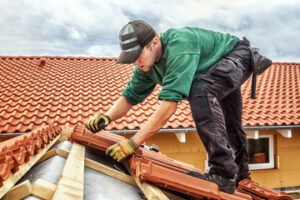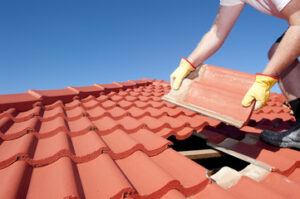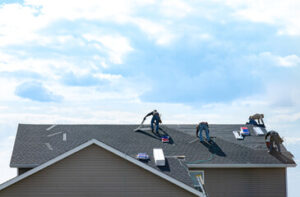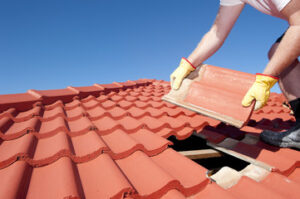Your roof can be damaged by weather or deteriorate over time. A roof inspection can uncover problems you may not notice such as a missing shingle or sagging gutters.

Your inspector will check soffit material, shingles and slate for damage, moss or rot. They will also examine pipe boots, roof vents and gable vents to ensure they are properly sealed. Reach out to Corpus Christi Roofing CO for expert assistance.
The shingles on a roof provide the first line of defense against water infiltration. A home inspector carefully surveys the shingles for damage and signs of leaks. They also check for the proper coverage of insulation and adequate ventilation. If a roof is leaking, the home’s structure is at risk of moisture damage and mold growth.
A roof’s structure is also inspected for sagging, cracks, and deterioration. A flat roof’s structural integrity is particularly important, as it is more susceptible to ponding water and membrane damage. A properly inspected and maintained roof can last 30 years or more with regular maintenance.
If a roof is nearing the end of its lifespan, the homeowner may want to consider a replacement. A professional roofing contractor can work with homeowners to plan for a new roof and ensure the proper installation process.
Inspecting a shingle roof can be a dangerous task, so a professional is the best choice to avoid serious injury or property damage. A professional will use a ladder or drone to safely evaluate the entire surface of a roof. They will look for shingle granules, which indicate the age of a shingle, and check for cracks or missing shingles.
The inspector will also examine the gutters to make sure they are clean and functioning correctly. Clogged gutters can cause water backup and roof damage. They will also assess the condition of chimneys and valleys. Chimneys are prone to leaking and require special care.
The inspection process can uncover problems that are not immediately apparent, including sagging, cracks, and missing shingles. These issues can lead to expensive repairs and even a full roof replacement. A home inspection can prevent these hidden problems and help homeowners budget for future maintenance. A reputable roofing company will offer thorough and honest assessments of a home’s roof. They will explain their findings in detail and recommend the best course of action for the homeowner. They will also provide cost estimates for recommended repair and maintenance work. This helps homeowners understand the full scope of their investment and plan accordingly.
Flashing
Flashing are strips of water-resistant material that prevent leaks in vulnerable areas of a roof. They are typically installed around chimneys, dormers, vent pipes and window openings. Flashing is also used to seal the gap between a roof and walls. If the flashing is damaged or not functioning properly, it can lead to leaking and damage in both structures. A professional roof inspector will inspect the condition of the flashing during a roof inspection. They will look for signs of damage, wear and tear or improper installation and repair. They will also evaluate the condition of any penetration seals and make recommendations if necessary.
A professional roof inspector will check the condition of the flashing at all roof intersections, projections and any gaps or cracks. They will also check the condition of any roof penetrations such as vent pipes, chimneys or skylights. They will also examine the conditions of any attic ventilation systems and look for blockages or standing water that may hinder drainage.
If the flashing is missing or in poor condition, they will recommend replacement to ensure the integrity of the roof and prevent moisture intrusion. They will check for any rust and corrosion, as well as checking the joints in the flashing to ensure they are securely fastened.
While many professional roof inspectors prefer to use a ladder to examine the entire surface of a roof, they may sometimes choose to walk on top of the building and take a closer look at the flashing. This is especially important for flat or sloped roofs that have complex flashing and valleys. They will walk along the edges and check for any waviness or areas where the flashing has not been fully sealed or fastened.
Because flashing is often exposed to harsh weather elements, it can easily deteriorate over time and become a source of leaks. They will also evaluate the condition of any gutters and downspouts, making sure they are in good working order. They will also check the condition of attic ventilation, which is essential for both a healthy roof and the home as a whole. A lack of attic ventilation dramatically shortens a roof’s lifespan and increases energy bills.
Gutters
Gutters are responsible for transporting runoff from the roof to a proper drainage system. They help prevent various roofing issues such as leaks and mold growth. In addition, a well-functioning gutter system protects the foundation and siding of your home from water damage. During a gutter inspection, roof specialists check for physical damage to the gutters and their components, clogs, and efficient downspout flow. They also look for signs of moisture or mold inside the attic which could indicate a problem with the ventilation, insulation or roofing systems.
Gutter inspections are important because they help to identify and prevent any problems that can arise from the troughs, downspouts, fascia, soffit, or other roof components. The most common issue is the accumulation of leaves and debris, which can block the drain and cause overflows. In addition, if the gutters are improperly sloped, the water may not be channeled away from your house. This can lead to erosion, basement flooding, foundation problems, and other serious damage.
A gutter system consists of several troughs that are attached to the roofline and extend down the sides of the structure. These troughs collect rainwater from the roofline and discharge it into downspouts, which then carry the water off of the property. When the gutters are functioning properly, they help to reduce the amount of erosion that can occur around the foundation of a home, prevent basement or crawl space flooding, and keep paint and stain from damaging the exterior of a home.
If your gutters are in poor condition, they will need to be replaced or repaired. Gutters can be made from a variety of materials, including aluminum, galvanized steel, and vinyl. A professional will be able to advise you on the best option for your home.
Gutter maintenance is recommended on a regular basis, especially after large storms. During a roof inspection, the inspector will use a tall ladder to climb up and remove any gunk that has collected in the gutter troughs. They will also clean out the downspouts to ensure that they are not blocked by debris. They will also inspect the gutters and downspouts for leaks, rust or corrosion, and other damages to the troughs, fascia, and soffit areas.
Attic
While home inspectors often conduct exterior roof inspections, many also check the attic and insulation as part of a thorough home inspection. The attic gives the inspector a good look at the roof sheathing and framing from above and can reveal issues not easily visible from ground level. In addition, the attic can help determine whether a roof has proper ventilation. If not, a roof can become too warm and cause shingles to break down.
When checking the attic, the home inspector will look for stains on sheathing or wood framing that indicate active leakage. He or she will also look for rust or corrosion on the thin flashing that lines penetrations such as skylights, chimneys and vent pipes. These are common locations for leaks. The inspector will also inspect the soffit and fascia boards for damage, such as cracking, warping and rot. These are areas where water can enter the home, causing damage to the attic and interior rooms.
If the attic is accessible, the inspector will check the insulation to ensure that it meets industry standards. He or she will also look for any signs of moisture such as mold or mildew, which can signal poor attic ventilation. The attic must be well ventilated to keep the shingles, sheathing and framing healthy. In addition, well-ventilated attics help prevent ice dams in the winter, which can cause serious roof and gutter damage as well as water intrusion into the home.
If the attic is inaccessible or if it has a drop ceiling, a separate attic inspection will be required, adding to the cost of the roof inspection. An infrared scan can be used instead of a physical inspection in these cases, but the cost is significantly higher. The infrared inspection is especially useful on older homes with inaccessible attics, or if the roof structure has a very steep pitch that makes it unsafe to walk on. Also, the infrared scan cannot be performed during rain or snow as it requires a clear view of the attic floor. The attic is an important part of a complete roof inspection, and it’s recommended that homeowners do regular maintenance to keep theirs in good condition.


